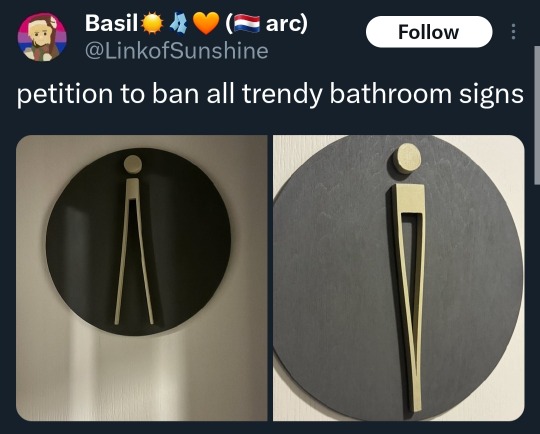Text

they dont even realise their own comedy
#probably because you got in online drama when accusing your former coworkers of homophobia and transphobia towards you#then it came out you were making the exact same homophobic jokes (as well as racist ones)#tried so hard to be relevant to a situation that didn't involve him and hit himself with his own backswing#you were no one's favourite in roosterteeth or achievement hunter
61 notes
·
View notes
Text
I’m gonna need 3-5 business weeks to form an opinion on this album
223 notes
·
View notes
Text
one of the teams in street woman fighter very specifically did a dance to born this way, collabed with a gay male dance crew called coming out, and JO KWON, and the show STILL cut out the 'no matter gay straight or bi' line in the song. korean broadcasting networks will die before they stop forcing an edited version of that song.
3 notes
·
View notes
Text
It seems like that Drew Pearce, the writer, used Amber Heard/johnny depp joke in the movie ''The Fall Guy''.

It baffles me that still some people treat domestic abuse as a joke.
103 notes
·
View notes
Text
wow, they casually drop in in episode 6 of the show that she is hard of hearing and wears a hearing aid. you rarely see that kind of representation and openness about disability in korea, let alone on a tv show, so that's super cool.
sucks though because she's a b-girl, but she can't breakdance with the hearing aid on, so she can only hear parts of the music. but still also won a youth olympic medal in 2018. sick,
yell from street woman fighter.....
2 notes
·
View notes
Text
i would die for gabee
#at the start of the show for like the first 20 minutes she's posed as the 'catty' villain#but after that she's so sweet and funny#and tries to be tough and cool but gets excited and emotional#my favourite kind of women are the ones that superficially are 'mean/cool girls' but are very girls girls and supportive and enthusiastic
0 notes
Text
yell from street woman fighter.....
2 notes
·
View notes
Text
my fucking idiot landlord and her husband got a patio deck built and for the safety fence around it....it's just sheets of thick glass. It was installed only about 3 months ago, and there has been at least 10 bird deaths since. 3 of those being TODAY. Not even a week after 1 died from it, I get up today and there are three dead birds below the glass.
She refuses to get anything done to prevent this, and just gets her husband to chuck the bodies into the bushes. They've largely been blackbirds so far, but we have multiple native and/or threatened species in this area. Also, because birds keep hitting it, the glass is already scratched and scuffed and dirty.
7 notes
·
View notes
Text
The Troubling Trend in Teenage Sex
Peggy Orenstein out here doing God's work
NY Times 4/12/24

By Peggy Orenstein
Ms. Orenstein is the author of “Boys & Sex: Young Men on Hookups, Love, Porn, Consent and Navigating the New Masculinity” and “Girls & Sex: Navigating the Complicated New Landscape.”
Debby Herbenick is one of the foremost researchers on American sexual behavior. The director of the Center for Sexual Health Promotion at Indiana University and the author of the pointedly titled book “Yes, Your Kid,” she usually shares her data, no matter how explicit, without judgment. So I was surprised by how concerned she seemed when we checked in on Zoom recently: “I haven’t often felt so strongly about getting research out there,” she told me. “But this is lifesaving.”
For the past four years, Dr. Herbenick has been tracking the rapid rise of “rough sex” among college students, particularly sexual strangulation, or what is colloquially referred to as choking. Nearly two-thirds of women in her most recent campus-representative survey of 5,000 students at an anonymized “major Midwestern university” said a partner had choked them during sex (one-third in their most recent encounter). The rate of those women who said they were between the ages 12 and 17 the first time that happened had shot up to 40 percent from one in four.
As someone who’s been writing for well over a decade about young people’s attitudes and early experience with sex in all its forms, I’d also begun clocking this phenomenon. I was initially startled in early 2020 when, during a post-talk Q. and A. at an independent high school, a 16-year-old girl asked, “How come boys all want to choke you?” In a different class, a 15-year-old boy wanted to know, “Why do girls all want to be choked?” They do? Not long after, a college sophomore (and longtime interview subject) contacted me after her roommate came home in tears because a hookup partner, without warning, had put both hands on her throat and squeezed.
I started to ask more, and the stories piled up. Another sophomore confided that she enjoyed being choked by her boyfriend, though it was important for a partner to be “properly educated” — pressing on the sides of the neck, for example, rather than the trachea. (Note: There is no safe way to strangle someone.) A male freshman said “girls expected” to be choked and, even though he didn’t want to do it, refusing would make him seem like a “simp.” And a senior in high school was angry that her friends called her “vanilla” when she complained that her boyfriend had choked her.
Sexual strangulation, nearly always of women in heterosexual pornography, has long been a staple on free sites, those default sources of sex ed for teens. As with anything else, repeat exposure can render the once appalling appealing. It’s not uncommon for behaviors to be normalized in porn, move within a few years to mainstream media, then, in what may become a feedback loop, be adopted in the bedroom or the dorm room.
Choking, Dr. Herbenick said, seems to have made that first leap in a 2008 episode of Showtime’s “Californication,” where it was still depicted as outré, then accelerated after the success of “Fifty Shades of Grey.” By 2019, when a high school girl was choked in the pilot of HBO’s “Euphoria,” it was standard fare. A young woman was choked in the opener of “The Idol” (again on HBO and also, like “Euphoria,” created by Sam Levinson; what’s with him?). Ali Wong plays the proclivity for laughs in a Netflix special, and it’s a punchline in Tina Fey’s new “Mean Girls.” The chorus of Jack Harlow’s “Lovin On Me,” which topped Billboard’s Hot 100 chart for six nonconsecutive weeks this winter and has been viewed over 99 million times on YouTube, starts with, “I’m vanilla, baby, I’ll choke you, but I ain’t no killer, baby.” How-to articles abound on the internet, and social media algorithms feed young people (but typically not their unsuspecting parents) hundreds of #chokemedaddy memes along with memes that mock — even celebrate — the potential for hurting or killing female partners.
I’m not here to kink-shame (or anything-shame). And, anyway, many experienced BDSM practitioners discourage choking, believing it to be too dangerous. There are still relatively few studies on the subject, and most have been done by Dr. Herbenick and her colleagues. Reports among adolescents are now trickling out from the United Kingdom, Australia, Iceland, New Zealand and Italy.
Sign up for the Opinion Today newsletter Get expert analysis of the news and a guide to the big ideas shaping the world every weekday morning.
Twenty years ago, sexual asphyxiation appears to have been unusual among any demographic, let alone young people who were new to sex and iffy at communication. That’s changed radically in a short time, with health consequences that parents, educators, medical professionals, sexual consent advocates and teens themselves urgently need to understand.
Sexual trends can spread quickly on campus and, to an extent, in every direction. But, at least among straight kids, I’ve sometimes noticed a pattern: Those that involve basic physical gratification — like receiving oral sex in hookups — tend to favor men. Those that might entail pain or submission, like choking, are generally more for women.
So, while undergrads of all genders and sexualities in Dr. Herbenick’s surveys report both choking and being choked, straight and bisexual young women are far more likely to have been the subjects of the behavior; the gap widens with greater occurrences. (In a separate study, Dr. Herbenick and her colleagues found the behavior repeated across the United States, particularly for adults under 40, and not just among college students.) Alcohol may well be involved, and while the act is often engaged in with a steady partner, a quarter of young women said partners they’d had sex with on the day they’d met also choked them.
Either way, most say that their partners never or only sometimes asked before grabbing their necks. For many, there had been moments when they couldn’t breathe or speak, compromising the ability to withdraw consent, if they’d given it. No wonder that, in a separate study by Dr. Herbenick, choking was among the most frequently listed sex acts young women said had scared them, reporting that it sometimes made them worry whether they’d survive.
Among girls and women I’ve spoken with, many did not want or like to be sexually strangled, though in an otherwise desired encounter they didn’t name it as assault. Still, a sizable number were enthusiastic; they requested it. It is exciting to feel so vulnerable, a college junior explained. The power dynamic turns her on; oxygen deprivation to the brain can trigger euphoria.
That same young woman, incidentally, had never climaxed with a partner: While the prevalence of choking has skyrocketed, rates of orgasm among young women have not increased, nor has the “orgasm gap” disappeared among heterosexual couples. “It indicates they’re not doing other things to enhance female arousal or pleasure,” Dr. Herbenick said.
When, for instance, she asked one male student who said he choked his partner whether he’d ever tried using a vibrator instead, he recoiled. “Why would I do that?” he asked.
Perhaps, she responded, because it would be more likely to produce orgasm without risking, you know, death.
In my interviews, college students have seen male orgasm as a given; women’s is nice if it happens, but certainly not expected or necessarily prioritized (by either partner). It makes sense, then, that fulfillment would be less the motivator for choking than appearing adventurous or kinky. Such performances don’t always feel good.
“Personally, my hypothesis is that this is one of the reasons young people are delaying or having less sex,” Dr. Herbenick said. “Because it’s uncomfortable and weird and scary. At times some of them literally think someone is assaulting them but they don’t know. Those are the only sexual experiences for some people. And it’s not just once they’ve gotten naked. They’ll say things like, ‘I’ve only tried to make out with someone once because he started choking and hitting me.’”
Keisuke Kawata, a neuroscientist at Indiana University’s School of Public Health, was one of the first researchers to sound the alarm on how the cumulative, seemingly inconsequential, sub-concussive hits football players sustain (as opposed to the occasional hard blow) were key to triggering C.T.E., the degenerative brain disease. He’s a good judge of serious threats to the brain. In response to Dr. Herbenick’s work, he’s turning his attention to sexual strangulation. “I see a similarity” to C.T.E., he told me, “though the mechanism of injury is very different.” In this case, it is oxygen-blocking pressure to the throat, frequently in light, repeated bursts of a few seconds each.
Strangulation — sexual or otherwise — often leaves few visible marks and can be easily overlooked as a cause of death. Those whose experiences are nonlethal rarely seek medical attention, because any injuries seem minor: Young women Dr. Herbenick studied mostly reported lightheadedness, headaches, neck pain, temporary loss of coordination and ear ringing. The symptoms resolve, and all seems well. But, as with those N.F.L. players, the true effects are silent, potentially not showing up for days, weeks, even years.
According to the American Academy of Neurology, restricting blood flow to the brain, even briefly, can cause permanent injury, including stroke and cognitive impairment. In M.R.I.s conducted by Dr. Kawata and his colleagues (including Dr. Herbenick, who is a co-author of his papers on strangulation), undergraduate women who have been repeatedly choked show a reduction in cortical folding in the brain compared with a never-choked control group. They also showed widespread cortical thickening, an inflammation response that is associated with elevated risk of later-onset mental illness. In completing simple memory tasks, their brains had to work far harder than the control group, recruiting from more regions to achieve the same level of accuracy.
The hemispheres in the choked group’s brains, too, were badly skewed, with the right side hyperactive and the left underperforming. A similar imbalance is associated with mood disorders — and indeed in Dr. Herbenick’s surveys girls and women who had been choked were more likely than others (or choked men) to have experienced overwhelming anxiety, as well as sadness and loneliness, with the effect more pronounced as the incidence rose: Women who had experienced more than five instances of choking were two and a half times as likely as those who had never been choked to say they had been so depressed within the previous 30 days they couldn’t function. Whether girls and women with mental health challenges are more likely to seek out (or be subjected to) choking, choking causes mood disorders, or some combination of the two is still unclear. But hypoxia, or oxygen deprivation — judging by what research has shown about other types of traumatic brain injury — could be a contributing factor. Given the soaring rates of depression and anxiety among young women, that warrants concern.
Now consider that every year Dr. Herbenick has done her survey, the number of females reporting extreme effects from strangulation (neck swelling, loss of consciousness, losing control of urinary function) has crept up. Among those who’ve been choked, the rate of becoming what students call “cloudy” — close to passing out, but not crossing the line — is now one in five, a huge proportion. All of this indicates partners are pressing on necks longer and harder.
The physical, cognitive and psychological impacts of sexual choking are disturbing. So is the idea that at a time when women’s social, economic, educational and political power are in ascent (even if some of those rights may be in jeopardy), when #MeToo has made progress against harassment and assault, there has been the popularization of a sex act that can damage our brains, impair intellectual functioning, undermine mental health, even kill us. Nonfatal strangulation, one of the most significant indicators that a man will murder his female partner (strangulation is also one of the most common methods used for doing so), has somehow been eroticized and made consensual, at least consensual enough. Yet, the outcomes are largely the same: Women’s brains and bodies don’t distinguish whether they are being harmed out of hate or out of love.
By now I’m guessing that parents are curled under their chairs in a fetal position. Or perhaps thinking, “No, not my kid!” (see: title of Dr. Herbenick’s book above, which, by the way, contains an entire chapter on how to talk to your teen about “rough sex”).
I get it. It’s scary stuff. Dr. Herbenick is worried; I am, too. And we are hardly some anti-sex, wait-till-marriage crusaders. But I don’t think our only option is to wring our hands over what young people are doing.
Parents should take a beat and consider how they might give their children relevant information in a way that they can hear it. Maybe reiterate that they want them to have a pleasurable sex life — you have already said that, right? — and also want them to be safe. Tell them that misinformation about certain practices, including choking, is rampant, that in reality it has grave health consequences. Plus, whether or not a partner initially requested it, if things go wrong, you’re generally criminally on the hook.
Dr. Herbenick suggests reminding them that there are other, lower-risk ways to be exploratory or adventurous if that is what they are after, but it would be wisest to delay any “rough sex” until they are older and more skilled at communicating. She offers language when negotiating with a new partner, such as, “By the way, I’m not comfortable with” — choking, or other escalating behaviors such as name-calling, spitting and genital slapping — “so please don’t do it/don’t ask me to do it to you.” They could also add what they are into and want to do together.
I’d like to point high school health teachers to evidence-based porn literacy curricula, but I realize that incorporating such lessons into their classrooms could cost them their jobs. Shafia Zaloom, a lecturer at the Harvard Graduate School of Education, recommends, if that’s the case, grounding discussions in mainstream and social media. There are plenty of opportunities. “You can use it to deconstruct gender norms, power dynamics in relationships, ‘performative’ trends that don’t represent most people’s healthy behaviors,” she said, “especially depictions of people putting pressure on someone’s neck or chest.”
I also know that pediatricians, like other adults, struggle when talking to adolescents about sex (the typical conversation, if it happens, lasts 40 seconds). Then again, they already caution younger children to use a helmet when they ride a bike (because heads and necks are delicate!); they can mention that teens might hear about things people do in sexual situations, including choking, then explain the impact on brain health and why such behavior is best avoided. They should emphasize that if, for any reason — a fall, a sports mishap or anything else — a young person develops symptoms of head trauma, they should come in immediately, no judgment, for help in healing.
The role and responsibility of the entertainment industry is a tangled knot: Media reflects behavior but also drives it, either expanding possibilities or increasing risks. There is precedent for accountability. The European Union now requires age verification on the world’s largest porn sites (in ways that preserve user privacy, whatever that means on the internet); that discussion, unsurprisingly, had been politicized here. Social media platforms have already been pushed to ban content promoting eating disorders, self-harm and suicide — they should likewise be pressured to ban content promoting choking. Traditional formats can stop glamorizing strangulation, making light of it, spreading false information, using it to signal female characters’ complexity or sexual awakening. Young people’s sexual scripts are shaped by what they watch, scroll by and listen to — unprecedentedly so. They deserve, and desperately need, models of interactions that are respectful, communicative, mutual and, at the very least, safe.
219 notes
·
View notes
Text
this is expressly due to the national parks. People think pandas are terrible at breeding, with low pregnancy rates, but it's only like that in captivity. They are likely highly sensitive to stress and intervention. Leave them be, in a wild habitat and their breeding rate shoots up.
The population of giant pandas in the wild has nearly doubled as China steps up its conservation efforts.
China’s National Forestry and Grassland Administration said on Jan 25 there are now around 1,900 pandas in the wild from some 1,100 in the 1980s.
This has been due to China’s efforts to protect the species, considered a national treasure, said Mr Zhang Yue, an official with the administration.
The Giant Panda National Park was established in October 2021, covering a total area of over 22,000 sq km and providing a home to around 72 per cent of the wild giant panda population.
Protected areas for giant pandas have grown from 1.39 million ha to 2.58 million ha since 2012.
The International Union for Conservation of Nature has adjusted the status of giant pandas from “endangered” to “vulnerable”.
“This indicates that China’s giant panda conservation efforts have been recognised by the international wildlife conservation community,” Mr Zhang said.
The global captive population of giant pandas, meanwhile, has now reached 728, with 46 pandas successfully bred in captivity in 2023.
The genetic diversity of captive giant pandas has also improved. The current captive population of giant pandas can maintain 90 per cent genetic diversity for up to 200 years.
As for giant pandas living abroad, Mr Zhang said China has organised field inspections and assessments of 23 overseas cooperation institutions in 19 countries since 2023.
“The cooperation institutions generally meet the requirements in terms of venue construction, feeding and nursing, and disease prevention and control measures,” Mr Zhang said, adding that pandas living abroad are generally “in good health”.
He said China will further improve the international cooperation management mechanism for giant pandas, carry out regular daily health monitoring and field inspection and assessment, and continue to strengthen cooperation with international partners for the protection of endangered species and biodiversity.
-via The Straits Times, January 25, 2024
987 notes
·
View notes
Photo




iconic close up ending shots 🎥
ready or not (2019) dir. matt bettinelli-olphin, tyler gillet
midsommar (2019) dir. ari aster
pearl (2022) dir. ti west
the menu (2022) dir. mark mylod
2K notes
·
View notes
Text
having a horrible workplace sucks, because even once you're out of it, the smallest trigger can remind you of something related to them and then you're filled with rage and bitterness again.
7 notes
·
View notes
Text
gender critical views are protected in multiple countries, either by the cover of political view, or by court cases. You are asking for a discrimination suit.

and this is why i 1. never share my social media in professional settings and 2. only post on tumblr
411 notes
·
View notes






